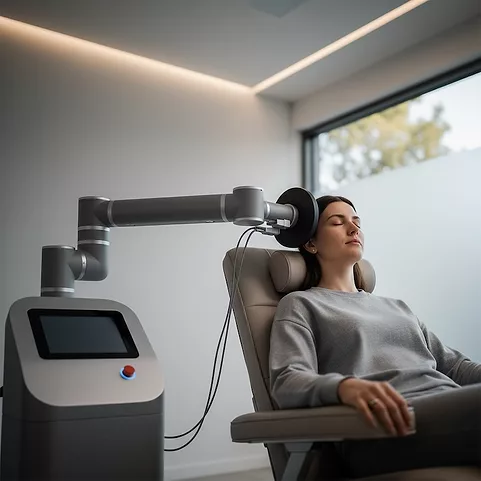Transcranial Direct Current Stimulation
Transcranial direct current stimulation (tDCS) is a noninvasive brain stimulation device that uses a low-intensity current to stimulate specific areas of the brain. Although popular for depression and other conditions, it is not cleared by the FDA. A growing community of students, professionals, and hobbyists, as well as people with mental health conditions, are using tDCS devices at home. They may be using tDCS to enhance their cognitive abilities or to alleviate certain physical or mental health conditions. Many purchase commercially available tDCS devices online ($100–$500) or build their own using kits ($20–$150).
Is tDCS effective?
While tDCS for depression treatment is backed by controlled trials, its evidence base isn’t as solid as that of established therapies, and its effect size is fairly small (0.3). This effect size was determined from a meta-analysis of 11 tDCS studies focused on depression that used sham devices as controls (Meron D et al, Neurosci Biobehav Rev 2015;57:46–52).
Nearly all the studies reviewed suffered from small sample sizes (less than 100 participants) and showed mixed results. One of the larger, more statistically robust studies divided 120 participants with major depressive disorder into four groups: tDCS with placebo, tDCS with the antidepressant sertraline, and their respective sham counterparts. Notably, 20% of the participants had treatment-resistant depression. The results showed that combining sertraline with tDCS led to a 12-point reduction in the Montgomery–Åsberg Depression Rating Scale (MADRS) score compared to placebo, while tDCS alone decreased the MADRS score by 6 points. This highlights the enhanced effectiveness of combination therapy (Brunoni A et al, JAMA Psychiatry 2013;70(4):383–391), as reported in the April 2013 TCPR.
tDCS also holds promise for treating other conditions, such as generalized anxiety disorder and attention deficit hyperactivity disorder, but the data supporting these uses are limited and based on smaller trials.
Is tDCS safe?
The FDA has not cleared tDCS for any indication, so it is always prescribed off-label. It is not without risk (Oh J et al, Clin Psychopharmacol Neurosci 2022;20(1):87–96). Patients may lack the knowledge or training necessary to use the device safely and effectively, and there is a risk that the user will push the voltage beyond the studied range. This can cause skin irritation on the stimulation areas, neck pain, headaches, and tingling sensations.
Additionally, any unmonitored psychiatric treatment carries safety concerns. Depression affects judgment in ways that interfere with insight and treatment planning, leading to delays in recovery or—in the worst case—suicide.
Mechanism of action
Like transcranial magnetic stimulation (TMS), tDCS operates via electromagnetic fields to evoke neural activity. However, the two methods differ in their intensity and the nature of their stimulation.
TMS applies robust magnetic pulses that are capable of inducing action potentials, the swift alterations in transmembrane neuronal voltage that transmit information. On the other hand, tDCS uses a substantially weaker current, between 0.5 and 2 milliamperes, that doesn’t prompt action potentials. Rather, it can subtly modify the voltage within neurons. For a point of reference, ECT administers approximately 800 milliamperes per impulse, a significantly higher amount.
Researchers still don’t fully understand the underlying mechanisms of tDCS, but the technique may influence the activity of neurotransmitters such as serotonin and dopamine. Enhanced neuronal signaling has been noted when tDCS is combined with substances like citalopram or levodopa (Nitsche M et al, Biol Psychiatry 2009;66(5):503–508; Kuo M et al, Cereb Cortex 2008; 18(3):648–651).
Additionally, evidence from animal models suggests that tDCS might boost neuroplasticity, a vital process for learning and memory. This observation was derived from experiments where tDCS was paired with thalamic stimulation (Fritsch B et al, Neuron 2010;66(2):198–204).
Clinical practice insights
Can tDCS response predict TMS response? We have no head-to-head studies of the two methods, but we do know that their mechanisms differ as described earlier. We also know that other forms of electromagnetic stimulation therapy, like ECT, are effective as an adjunctive treatment for depression. Serotonergic and dopaminergic agents also appear to synergize with tDCS, which makes it favorable when supplementing ongoing pharmacotherapy.
If your patient decides to pursue tDCS, have them track their symptoms with a rating scale like the Patient Health Questionnaire (PHQ-9) before and after tDCS.
Dosing depends on three parameters: current, duration, and location. The current is between 1 and 2 milliamperes. The duration is 20 minutes daily for five to 15 days. Most studies place the anode patch over the left dorsolateral and ventromedial cortex (known as F3 in EEG placement) and the cathode patch over the right supraorbital area of the forehead (F4 in EEG placement). These locations can be identified with three head measurements: head circumference, distance from nasion to inion (nose to back of the head), and distance from tragus to tragus (ear to ear). You can find software that helps pinpoint this area at www.clinicalresearcher.org/software.htm (Beam W et al, Brain Stim 2010;2(1):50–54). Finally, for a primer on how to implement tDCS, see www.tinyurl.com/4zceu4k
CARLAT VERDICT
tDCS involves passing direct current across the brain. It is weaker than TMS, but it has some benefits for depression. It is not recommended for treatment-resistant depression.


_-The-Breakthrough-Antipsychotic-That-Could-Change-Everything.webp?t=1729528747)



